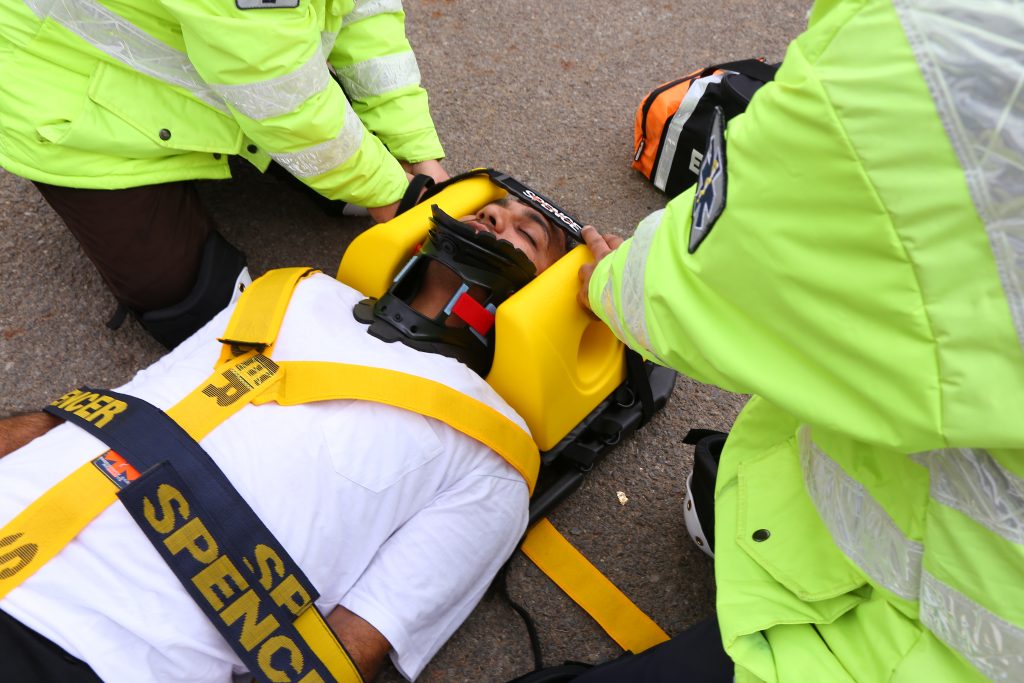Long backboards are commonly used to attempt to provide rigid spinal immobilization among EMS trauma patients. Place rolled blankets on both sides of the patients head.

Ems Training How To Apply Full Spinal Immobilization Using A Backboard Youtube
Position splint against the uninjured leg to adjust the length.

. Secure the torso and then center the patient on the board. Have the patient exhale before fastening the torso straps. B tightly secure the patients head to the board with cravats.
Place rolled blankets on both sides of the patients head. Ensure that you secure the torso before securing the head. Ensure that you secure the torso before securing the head.
The patients body should be secured to the device. 1 on a question When immobilizing the patients head to the long backboard you should. Most ambulance services have moved to a more modern vest-style.
Patients with penetrating trauma to the head neck or torso and no evidence of spinal injury should not be immobilized on a backboard. Prior to immobilizing an anxious patient with a suspected spinal injury on a. Follow the commands of the person at the patients torso.
Asked Nov 8 2021 in Health Professions by Fantastic_One A. Take appropriate body substance isolation precautions. Have the patient exhale before fastening the torso straps.
When immobilizing a child on a long backboard you should. Place blankets behind the patients head. A patient on a backboard or stretcher can be lifted and carried by four providers in a diamond carry with one provider at the head end of the device one at the foot end and one at each side of the patients torso.
Secure the torso and then center the patient on the board. People also ask what is a short backboard used for. When moving a patient on a long backboard you should.
Place splint under the patients leg and. Follow the commands of the person at the patients torso. Keep the patients head and spine immobilized to avoid movement.
An injured patients head should be secured to the long backboard only after. Ensure that you secure the torso before securing the head. When immobilizing the patients head to the long backboard you should.
When immobilizing a patient on a long backboard you should. When immobilizing a patient on a long backboard you should. Force the head into a neutral alignment.
When immobilizing a patient to a long backboard you should take standard precautions and then. When immobilizing a patient with a kyphotic spine to a long backboard the EMT would MOST likely have to. When immobilizing the patients head to the long backboard you should.
You and your partner are assisting paramedics in securing an injured patient to a long backboard. Secure the head to the board before securing the torso and legs. Instruct a helper to manually stabilize the patients head for in-line stabilization.
Device to immobilize the patients cervical spine prior to using a long backboard. Asked Nov 27 2021 in Health Professions by jeetmang. Stabilize both sides of the head prior to applying a cervical collar.
Tightly secure the patients head to the board with cravats. Secure the torso and then center the patient on the board. Tightly secure the patients head to the board with cravats.
This EMT training video will help you prepare for the NREMTs practical exam station Spinal Immobilization Supine Patient More EMT training can be found a. Secure the head to the board before securing the torso and legs. However the benefit of long backboards is largely unproven.
When immobilizing the patients head to the long backboard you should. Ensure that the patients head is stabilized manually. The short backboard is used to remove a stable injured patient from a vehicle onto a long backboard.
A place rolled blankets on both sides of the patients head. When immobilizing a patient to a long backboard you should take standard precautions and then. When immobilizing a patient on a long backboard you should.
When immobilizing a patient on a long backboard you should. When immobilizing the patients head to the backboard you should Place rolled blankets on both sides of patient head The most effective way to prevent accidental movement of a patients head when strapping them to a long backboard is. When immobilizing a patient to a long backboard you should take standard precautions and then.
Secure the patients head before the torso. Ensure that you secure the torso before securing the head. You should keep your spine aligned and upright.
Place padding under the childs shoulders as needed. Size and apply a cervical collar to the patient if this has. Similarly it is asked how do you use a Hare traction splint.
Have the patient exhale before fastening the torso straps. One paramedic is supporting the patients head while the other paramedic and your partner are supporting the patients torso and legs. Assess each extremity for the presence of distal pulse motor function and sensory function.
The bodys functions that occur without conscious effort are regulated by the _________ nervous system. Typically on a long spine board the torso is secured with straps first then the abdomen or waist and then the lower body. Stabilize the injured leg.
Force the head into a neutral alignment. Asked Nov 27 2021 in Health Professions by jeetmang emergency-medical-services. When immobilizing a patient with a kyphotic spine to a long backboard the EMT would MOST likely have to.
Follow the commands of the person at the patients torso.

10 Steps To Perform A Correct Spinal Immobilization Of A Trauma Patient

Nremt Spinal Immobilization Supine Patient Back Board Firefighter Emt Guide Pass The Exam Youtube

An Evidence Review Of Prehospital Spinal Immobilization Jems Ems Emergency Medical Services Training Paramedic Emt News
0 Comments